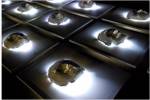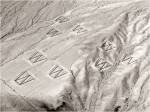http://fhs1973.wordpress.com/2011/05/21/modern-and-contemporary-art-of-the-middle-east-and-north-africa/
الفن المعاصر في العالم العربي وإيران
Since the recent developments in Tunisia and Egypt and probably to follow in other Arab countries, even the mainstream media have noticed that in the Arab world and Iran there is a desire for freedom and democracy. While in the Western World often reduced to essentialist clichés of the traditional Arab or the Muslim extremists the recent events show the opposite. The orientalist paradigm, as Edward Said has defined in 1978, or even the ‘neo-orientalist’ version (according to Salah Hassan), virulent since 9 / 11, are denounced by the images of Arab satellite channels like Al Jazeera. It proofs that there are definitely progressive and freedom-loving forces in the Middle East, as nowadays becomes visible for the whole world.

Wafaa Bilal (Iraq, US), from his project ’Domestic Tension’, 2007 (see for more http://wafaabilal.com/html/domesticTension.html )
Since the last few years there is an increasing interest in contemporary art from that region. Artists such as Mona Hatoum (Palestine), Shirin Neshat (Iran) and the architect Zaha Hadid (Iraq) were already visible in the international art circuit. Since the last five to ten years there are a number of names added, like Ghada Amer (Egypt), Akram Zaatari and Walid Ra’ad (Lebanon), Fareed Armaly and Emily Jacir (Palestine), Mounir Fatmi (Morocco), Farhad Mosheri ( Iran), Ahmed Mater (Saudi Arabia), Mohammed al- Shammerey and Wafaa Bilal (Iraq). Most of these artists are working and living in the Western World.

Walid Ra’ad/The Atlas Group (Lebanon), see http://www.theatlasgroup.org/index.html, at Documenta 11, Kassel, 2002

Mounir Fatmi (Morocco), The Connections, installation, 2003 – 2009, see http://www.mounirfatmi.com/2installation/connexions01.html
Yet the phenomenon of modern and contemporary art in the Middle East isn’t something of last decades. From the end of World War I, when most Arab countries arose in its present form, artists in several countries have sought manners to create their own form of international modernism. Important pioneers were Mahmud Mukhtar (since the twenties and thirties in Egypt), Jewad Selim (forties and fifties in Iraq), or Muhammad Melehi and Farid Belkahia (from the sixties in Morocco). These artists were the first who, having been trained mostly in the West, introduced modernist styles in their homeland. Since that time, artists in several Arab countries draw inspiration from both international modernism, and from traditions of their own cultural heritage.
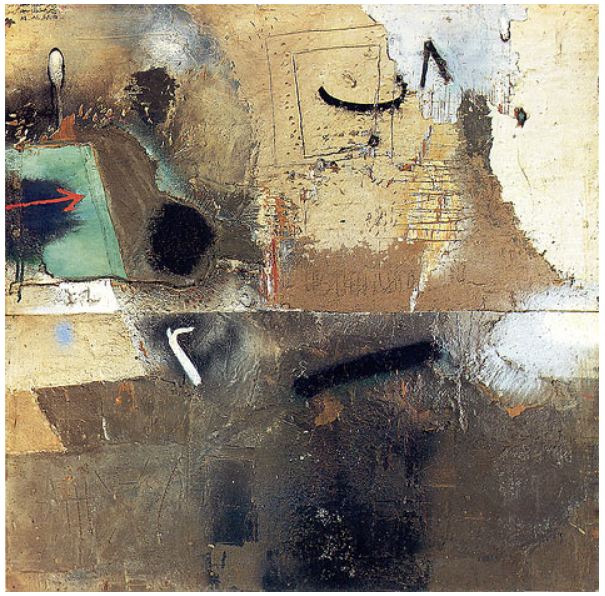
Shakir Hassan al-Said (Iraq), Objective Contemplations, oil on board, 1984, see http://universes-in-universe.org/eng/nafas/articles/2008/shakir_hassan_al_said/photos/08

Ali Omar Ermes (Lybia/UK), Fa, Ink and acryl on paper
The latter was not something noncommittal. In the decolonization process, the artists often explicitly took a stand against western colonialism. Increasing local traditions here was used often as a strategy. From the late sixties also other factors play a role. “Pan-Arabism” or even the search for a “Pan-Islamic identity” had an impact on the arts. This is obvious in what the French Moroccan art historian Brahim Alaoui called ‘l’ Ecole de Signe’, the ‘school of sign’. Abstract calligraphy and decorative traditions of Islamic art, were in many variations combined with contemporary abstract art. The main representatives of this unique tendency of modern Islamic art were Shakir Hassan al-Said (Iraq, deceased in 2004), and the still very active artists as Rachid Koraichi (Algeria, lives and works in France), Ali Omar Ermes (Libya, lives and works in England) and Wijdan Ali (Jordan). This direction found even a three dimensional variant, in the sculptures of the Iranian artist Parviz Tanavoli.

Laila Shawa (Palestine), Gun for Palestine (from ‘The Walls of Gaza’), silkscreen on canvas, 1995
What is particularly problematic for the development of contemporary art of the Middle East are the major crises of recent decades. The dictatorial regimes, the many wars, or, in the case of Palestine, the Israeli occupation, have often been a significant obstacle for the devolopment of the arts. If the arts were encouraged, it was often for propaganda purposes, with Iraq being the most extreme example (the many portraits and statues of Saddam Hussein speak for themselves). Many artists saw themselves thus forced to divert in the Diaspora (especially Palestinian and Iraqi artists). In the Netherlands there are well over the one hundred artists from the Middle East, of which the majority exists of refugees from Iraq (about eighty). Yet most of these artists are not known to the vast majority of the Dutch cultural institutions and the general public.

Mohamed Abla (Egypt), Looking for a Leader, acrylic on canvas, 2006
In the present context of on the one hand the increased aversion to the Islamic world in many European countries, which often manifests itself into populist political parties, or conspiracy theories about ‘Eurabia’ and, on the other hand, the very recent boom in the Arab world itself, it would be a great opportunity to make this art more visible to the rest of the world. The Middle East is in many respects a region with a lot of problems, but much is also considerably changing. The young people in Tunisia and Egypt and other Arab countries, who challenged their outdated dictatorships with blogs, facebook and twitter, have convincingly demonstrated this. Let us have a look at the arts. There is much to discover.
Floris Schreve
Amsterdam, March, 2011
originally published in ‘Kunstbeeld’, nr. 4, 2011 (see here the original Dutch version). Also published on Global Arab Network

Ahmed Mater (Saudi Arabia), Evolution of Man, Cairo Biennale, 2008. NB at the moment Mater is exhibiting in Amsterdam, at Willem Baars Project, Hoogte Kadijk 17, till the 30th of july. See http://www.baarsprojects.com/
Handout lecture ‘Modern and Contemporary art of the Arab World’
محاضرة الفن الحديث والمعاصر في العالم العربي
Diversity & Art, Amsterdam, 17-5-2011, at the occasion of the exhibition of the Dutch Iraqi artist Qassim Alsaedy
Click on the pictures to enlarge
Short introduction on the history and geography of the modern Arab World
- The Ottoman Empire
- The Sykes/Picot agreement
- The formation of the national states
- The Israeli/Palestinian conflict



Ottoman Empire 1739 Ottoman Empire 1914 The Sykes/Picot agreement


The modern Middle East The modern Arab World

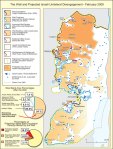
Palestinian loss of land 1948-2000 The current situation (2005)
The early modernist pioneers:


Mahmud Mukhtar Jewad Selim


Jewad Selim Faeq Hassan

Farid Belkahia
The ‘School of Sign’ (acc. Brahim Alaoui, curator of the Institut du Monde Arabe, Paris):



Shakir Hassan al-Said Ali Omar Ermes Rachid Koraichi
Other examples of ‘Arab Modernism’:



Mohamed Kacimi Dhia Azzawi Rafik el-Kamel
The Palestinian Diaspora:



Mona Hatoum Laila Shawa Emily Jacir
Recently emerged ‘international art’:



Walid Ra’ad/The Atlas Group Mounir Fatmi Ahmed Mater
Art and propaganda:
- Iraq (monuments, Victory Arch, Babylon, portraits of Saddam Husayn and Michel Aflaq, the founder of the Ba’thparty)
- Syria (portrait Havez al-Assad)
- Libya (portrait Muammar al-Qadhafi)


Victory Arch ‘Saddam as Saladin’



Statue of Michel Aflaq Statue of Havez al-Assad Muammar al-Qadhafi
The art of the ‘Arab Spring’ in Egypt:


Mohamed Abla Ahmed Bassiony
Iraqi artists in the Diaspora:



Rafa al-Nasiri Hanaa Mal Allah Ali Assaf

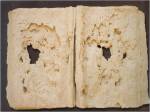

Wafaa Bilal Halim al-Karim Nedim Kufi



Hoshyar Rasheed Aras Kareem Ziad Haider

Qassim Alsaedy, Shortly after the War, mixed media (installation) Diversity&Art, May 2011 (see here an interview with Qassim Alsaedy at the opening-in Arabic)
Selected Bibliography
• Brahim Alaoui, Art Contemporain Arabe, Institut du Monde Arabe, Paris, 1996
• Brahim Alaoui, Mohamed Métalsi, Quatre Peintres Arabe Première ; Azzaoui, El Kamel, Kacimi, Marwan, Institut du Monde Arabe, Paris, 1988.
• Brahim Alaoui, Maria Lluïsa Borràs, Schilders uit de Maghreb (‘Painters of the Maghreb’), Centrum voor Beeldende Kunst, Gent (Belgium), 1994
• Brahim Alaoui, Laila Al Wahidi, Artistes Palestiniens Contemporains, Institut du Monde Arabe, Paris, 1997
• Wijdan Ali, Contemporary Art from the Islamic World, Al Saqi Books, London, 1989.
• Wijdan Ali, Modern Islamic Art; Development and continuity, University of Florida Press, 1997
• Hossein Amirsadeghi , Salwa Mikdadi, Nada Shabout, ao, New Vision; Arab Contemporary Art in the 21st Century, Thames and Hudson, London, 2009.
• Michael Archer, Guy Brett, Catherine de Zegher, Mona Hatoum, Phaidon Press, New York, 1997
• Ali Assaf, Mary Angela Shroth, Acqua Ferita/Wounded Water; Six Iraqi artists interpret the theme of water, Gangemi editore, Venice Biennale, 2011 (artists: Adel Abidin, Ahmed Alsoudani, Ali Assaf, Azad Nanakeli, Halim al-Karim, Walid Siti)
• Mouna Atassi, Contemporary Art in Syria, Damascus, 1998 • Wafaa Bilal (with Kari Lydersen), Shoot an Iraqi; Art, Life and Resistance Under the Gun, City Lights, New York, 2008
• Catherine David (ed),Tamass 2: Contemporary Arab Representations: Cairo, Witte De With Center For Contemporary Art, Rotterdam, 2005
• Saeb Eigner, Art of the Middle East; modern and contemporary art of the Arab World and Iran, Merrell, Londen/New York, 2010 (with an introduction of Zaha Hadid).
• Aida Eltori, Illuminations; Thirty days of running in the Space: Ahmed Basiony (1978-2011) , Venice Biennale, 2011
• Maysaloun Faraj (ed.), Strokes of genius; contemporary Iraqi art, Saqi Books, London, 2002 (see here the presentation of the Strokes of Genius exhibition)
• Mounir Fatmi, Fuck the architect, published on the occasion of the Brussels Biennal, 2008
• Liliane Karnouk, Modern Egyptian Art; the emergence of a National Style, American University of Cairo Press, 1988, Cairo
• Samir Al Khalil (pseudonym of Kanan Makiya), The Monument; art, vulgarity and responsibillity in Iraq, Andre Deutsch, London, 1991
• Robert Kluijver, Borders; contemporary Middle Eastern art and discourse, Gemak, The Hague, October 2007/ January 2009
• Mohamed Metalsi, Croisement de Signe, Institut du Monde Arabe, Parijs, 1989 (on ao Shakir Hassan al-Said)
• Revue Noire; African Contemporary Art/Art Contemporain Africain: Morocco/Maroc, nr. 33-34, 2ème semestre, 1999, Paris.
• Ahmed Fouad Selim, 7th International Biennial of Cairo, Cairo, 1998.
• Ahmed Fouad Selim, 8th International Biennial of Cairo, Cairo, 2001.
• M. Sijelmassi, l’Art Contemporain au Maroc, ACR Edition, Paris, 1889.
• Walid Sadek, Tony Chakar, Bilal Khbeiz, Tamass 1; Beirut/Lebanon, Witte De With Center For Contemporary Art, Rotterdam, 2002
• Paul Sloman (ed.), with contributions of Wijdan Ali, Nat Muller, Lindsey Moore ao, Contemporary Art in the Middle East, Black Dog Publishing, London, 2009
• Stephen Stapleton (ed.), with contributions of Venetia Porter, Ashraf Fayadh, Aarnout Helb, ao, Ahmed Mater, Booth-Clibborn Productions, Abha/London 2010 (see also www.ahmedmater.com)
• Rayya El Zein & Alex Ortiz, Signs of the Times: the Popular Literature of Tahrir; Protest Signs, Graffiti, and Street Art, New York, 2011 (see http://arteeast.org/pages/literature/641/)
Links to relevant websites of institutions, manifestations, magazines, museums and galleries for Contemporary Art of the Middle East and North Africa:
- al-Jadeed a review and record of Arab Art and Culture
- Artists of the Middle East online exhibition of the British Museum
- Arts, Culture and Place (ISIM Review nr. 22)
- Association for Modern and Contemporary Art of the Arab World, Iran, and Turkey (AMCA)
- Aya Art Gallery gallery/platform for contemporary art of Iraq (and other countries of the region) of Maysaloun Faraj and Ali Mousawi in London
- Ben Davis, The Iraqi Century of Art
- Bidoun magazine for art and culture of the Middle East
- Biennale of Cairo
- Contemporary Arab Art-Irak (Ara Gallery)- a small but fine selction of some of the most interesting Iraqi artists in the world (Dubai)
- Contemporary Arab Representations
- Dafatir (Iraqi notebook-project of Nada Shabout with several Iraqi artists spread over the world)
- Darat al-Funun The Khalid Shoman Foundation-Museum for modern and contemporary art in Amman (Jordan)
- EUMAN European Union Migrant Artists Network (Helsinki)- many Iraqi artists
- Greenbox Museum for Contemporary Art of Saudi Arabia, Amsterdam
- Institut du Monde Arabe (IMA) The famous Istitut du Monde Arabe in Paris has a large department for modern art
- International Network for Contemporary Iraqi Artists (INCIA)
- Iraqi Art.com
- Iraqi artists (Unverse in Universe) several articles on 27 Iraqi artists worldwide
- Iraqi Artists Association
- Iraqi Fine Artists Association
- Khalil Sakakini Cultural Centre a platform for contemporary art in Ramallah, Palestine
- Mashrabia Art Gallery A gallery and platform for contemporary art in Cairo
- Mathaf Arab Museum of Modern Art (Doha, Qatar)
- Nada Shabout, Shakir Hassan al-Said; a journey towards the One Dimension (Nafas)
- ‘Revolution in the Arab art scene?’ Deutsche Welle on the 10th Sjarjah Biennale
- Nafas Art Magazine Contemporary art from Islamic influenced countries and regions
- Wijdan Ali, Modern Art from the Arab World
- Word into Art (British Museum) Many leading artists from the Arab World and Iran
- Will the Arab Spring Bloom at the Venice Biennale?: A Preview of Four Politically Charged Displays; on the artists of Iraq, Lebanon, Palestine and Egypt, presented at the Venice Biennale
An Impression of the lecture, 17-5-2011, Diversity & Art, Amsterdam

On the screen a work of the Iraqi artist Rafa al-Nasiri

Three times Qassim Alsaedy’s Shortly after the War


In front: The Iraqi/Kurdish journalist Goran Baba Ali and Herman Divendal, director of the Human Rights Organisation for Artists AIDA (Association Internationale des Défence des Artistes)


Me (left) with the Embassador of Iraq in the Netherlands, H.E. Dr. Saad Al-Ali, and Qassim Alsaedy

Floris Schreve فلوريس سحرافا (أمستردام، هولندا)
photos during the lecture by Hesam Hama





















